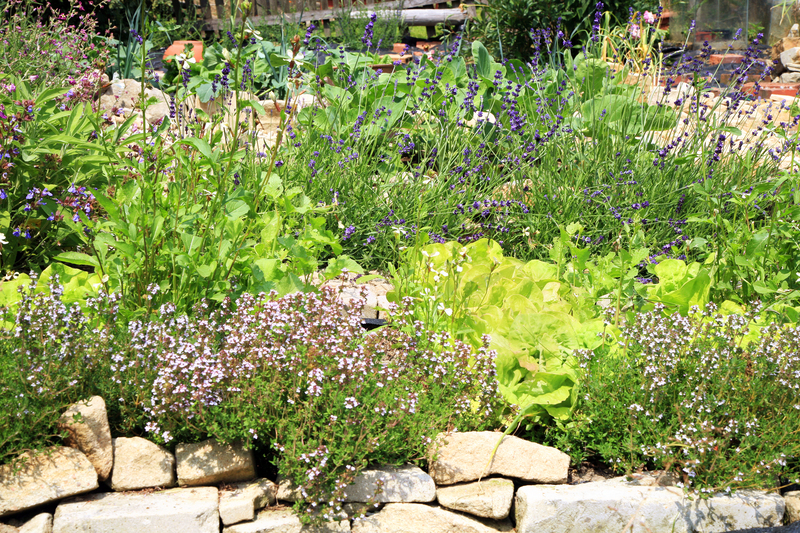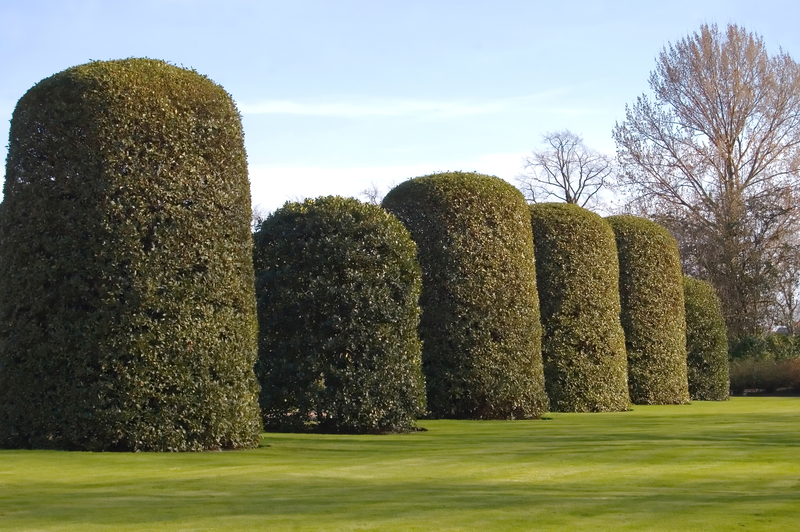Redefine Your Garden Space with Hedge Trimming Designs
Posted on 09/09/2025
Redefine Your Garden Space with Hedge Trimming Designs
If you've ever dreamed of creating a stunning, unique garden, hedge trimming designs are the secret ingredient. With carefully sculpted hedges, you can redefine your garden space, boost curb appeal, and add value to your home. Whether you're a novice gardener or a green-fingered expert, this comprehensive guide will inspire you to transform your landscape with imaginative hedge trimming ideas and techniques.
Why Opt for Creative Hedge Trimming Designs?
There's more to a well-manicured bush than mere neatness. Creative hedge trimming designs serve multiple purposes that go beyond aesthetics:
- Add Structure: Shaped hedges provide a distinct structure to your outdoor space, creating defined walkways and secluded garden rooms.
- Visual Interest: Ornamental topiary injects personality and drama, making your garden more engaging year-round.
- Privacy & Noise Reduction: Tall, carefully sculpted hedges act as living fences, offering privacy, shade, and sound insulation.
- Wildlife Haven: Intricately designed hedges can serve as protected habitats for birds and pollinators.
- Property Value: A well-designed landscape increases your property's curb appeal and overall value.

Popular Hedge Trimming Design Styles
Before you redefine your garden with hedge trimming designs, consider the most popular styles used by landscape designers:
1. Geometric Shapes
Geometric shapes, such as spheres, cubes, pyramids, and cones, create a sense of order and modernity. This style complements both formal European gardens and contemporary outdoor spaces.
2. Topiary Art
For a whimsical touch, experiment with topiary hedge designs. Sculpt your hedges into animals, spirals, abstract art, or even character figures. This classic form of horticultural artistry can transform any garden into a storybook landscape.
3. Naturalistic Trimming
Naturalistic or informal hedge trimming accentuates the plant's inherent growth pattern. By preserving natural curves and irregularities, you create lush, flowing hedges that blend seamlessly into woodland or cottage gardens.
4. Ornamental & Patterned Hedges
Patterned hedge trimming involves crafting designs, such as waves, chess-boards, or lattices, into a living tapestry. These techniques work wonderfully for statement fences or parterres in traditional and modern landscapes alike.
5. Living Garden Walls
Hedges can form living walls--vertical barriers topped with precise flat edges or adorned with creative notches and arches. This approach is perfect for maximizing small garden spaces and enhancing privacy.
Choosing the Right Plants for Hedge Trimming Designs
Not every shrub can be shaped into intricate designs. Plant selection is crucial if you want to achieve crisp, sustainable hedge trimming outcomes. Here are some top picks:
- Boxwood (Buxus): Classic for its dense foliage, boxwood is ideal for topiary and geometric shapes.
- Yew (Taxus): Hardy and long-living, yew is perfect for intricate designs and thrives in both sun and shade.
- Privet (Ligustrum): This fast-grower works well for living fences and can withstand frequent trimming.
- Holly (Ilex): Adds texture and color with its glossy, evergreen leaves and festive berries.
- Lonicera (Honeysuckle): Excellent for informal, flowing shapes and wildlife-friendly hedges.
- Photinia: Vibrant new growth in red makes a striking hedge backdrop.
Tools & Techniques for Mastering Hedge Trimming Art
To excel in hedge trimming and design, invest in the right tools and practice these tried-and-tested techniques:
- Hand Shears: For precision tasks and topiary, sharp shears provide clean cuts without damaging foliage.
- Hedge Trimmers: Electric or gas-powered trimmers make quick work of large, straight edges.
- Loppers & Pruning Saws: For cutting thicker branches or rejuvenating overgrown hedges.
- String Lines & Stakes: Create straight lines or guides for geometric designs.
- Topiary Frames: Metal frames help beginners with complex hedge trimming patterns and animal shapes.
Best Practices for Precision Hedge Sculpting
Follow these techniques to define your garden with hedge trimming design expertise:
- Trim Young: Start pruning early to encourage dense growth and make shaping easier.
- Work Slowly: Gradually shear off foliage for better control, especially with intricate topiary.
- Cut at Slight Angles: Taper edges so the hedge base is wider than the top. This allows sunlight to reach all leaves, preventing browning.
- Step Back: Frequently check your progress from a distance for overall symmetry and balance.
- Maintain Regularly: Most formal designs require multiple trims per season for crisp results.
Creative Hedge Trimming Ideas to Transform Your Garden
Ready to redefine your garden with unique hedge art? Here are inspiring concepts to ignite your creativity:
Maze-Inspired Designs
Channel the elegance of grand estates with maze-style hedges. Even in a modest garden, low, looping hedges can create playful pathways and a sense of discovery.
Themed Topiary Gardens
Design a section of your yard based on a theme--such as forest animals, fantasy figures, or even abstract geometric shapes--using topiary hedge trimming as the focal point.
Outdoor Rooms with Living Walls
Use tall, shaped hedges to carve your outdoor space into "rooms": a dining nook, a reading corner, or a meditation area. Add arched doorways and windows for a fairytale effect.
Seasonal Accents and Color Contrasts
Blend different shrub species for dynamic seasonal effects. Photinia's red tips, holly's berries, and golden euonymus can create living mosaics of color and texture.
Modern Minimalist Edging
Geometric hedges are perfect as low borders and symmetrical accents around patios, driveways, or modern architecture--offering a clean, sophisticated look.
Wildlife-Friendly Sculptures
Integrate birdhouses, bee hotels, or stone features into your trimmed hedges for a double-duty design: artistry and ecological support.
Step-by-Step: Designing Your Own Hedge Trimming Masterpiece
Unleash your inner artist and redefine your garden space through hedge trimming design with this step-by-step plan:
- Plan Your Layout: Sketch your desired shapes, paths, or topiary outlines on paper. Consider your garden's style and dimensions.
- Select Suitable Species: Choose shrubs that suit your climate, soil, and design ambitions, focusing on those that respond well to pruning.
- Prepare the Soil: Enrich planting beds with compost and ensure adequate drainage to promote healthy growth.
- Plant with Spacing in Mind: Allow enough room for future growth and shaping by spacing plants appropriately.
- Install Guides: Use stakes, string lines, or frames to mark out the main shapes--especially for geometric or topiary work.
- Begin Initial Shaping: Prune lightly in the first year to encourage density and establish the basic outline.
- Maintain & Refine: Regularly trim and tweak your design as it grows, paying careful attention to symmetry and vigor.
Benefits of Creative Hedge Trimming for Garden Spaces
- Year-Round Beauty: Evergreen hedges stay vibrant even in winter, providing persistent structure and visual interest.
- Personalized Aesthetic: No two hedge designs need be alike. Customize your garden to reflect your personality and passions.
- Increased Functionality: Use hedges for screening, shelter, and windbreaks without sacrificing style.
- Environmental Value: Well-maintained hedge designs absorb CO?, filter pollutants, and offer vital habitats for birds and insects.
- Therapeutic Value: The act of trimming and shaping hedges can be meditative--offering a creative, hands-on escape in your own backyard.
Maintenance Tips for Lasting Hedge Art
To ensure your hedge trimming designs remain striking year after year, regular care is vital. Here's how to keep your living sculptures looking their best:
- Prune at the Right Time: Hedge trimming is best done in late spring and again in late summer, depending on the species.
- Feed and Mulch: Annual applications of slow-release fertilizer and organic mulch boost health and longevity.
- Water Wisely: New plantings require consistent moisture. Established hedges are generally drought-tolerant but benefit from deep, occasional watering.
- Inspect for Pests and Diseases: Watch for signs of leaf spot, caterpillars, or aphids and address promptly.
- Reshape When Necessary: Over time, hedges may become leggy. A hard prune (rejuvenation cut) can restore structure and density every few years.
Common Mistakes to Avoid in Hedge Trimming and Design
- Neglecting Regular Maintenance: Infrequent trimming leads to overgrown, unsightly hedges that are difficult to revive.
- Improper Shaping: Avoid trimming hedges narrower at the base; this prevents lower foliage from getting enough light, causing thinning and bare spots.
- Using Dull Tools: Blunt shears or trimmers make ragged cuts that damage plant tissue and slow recovery.
- Poor Plant Selection: Picking fast-growing, coarse-leaved shrubs may result in untidy designs.
- Ignoring Environmental Conditions: Place hedges where they can thrive; poor soil, excessive shade, or exposure can limit success.
Professional vs. DIY Hedge Trimming: Which Is Best for You?
While many home gardeners enjoy DIY hedge trimming for its artistry and satisfaction, intricate designs or large-scale projects may call for professional help. Consider your skill level, available time, and the complexity of your vision. Professional landscapers bring expert knowledge and can achieve stunning results in less time, especially for elaborate topiary or formal parterres.

Frequently Asked Questions About Hedge Trimming Designs
How often should I trim my hedges?
Most formal design hedges need two to three trims per year; informal or wildlife hedges can be pruned less frequently.
Can I create hedge designs with flowering shrubs?
Absolutely! Shrubs like lavender, mock orange, and lilac can be pruned into loose shapes. Just trim after flowering to avoid cutting off next year's blooms.
What's the fastest-growing plant for hedge designs?
Privet and laurel offer rapid growth for living fences, but boxwood and yew are best for topiary due to their density and ability to hold shape.
Is special training required for topiary art?
Not necessarily. Anyone can begin with basic shapes. Start with spheres or cubes, and use frames or guides to experiment with more complex designs as your skills grow.
Conclusion: Create Your Signature Garden with Hedge Trimming Art
There's no better way to redefine your garden space than by embracing the creative possibilities of hedge trimming designs. Whether you're drawn to precise geometric shapes, whimsical topiary, or lush, informal hedges, your imagination is the only limit. With patience, the right plants, and steady care, you'll enjoy an outdoor masterpiece that evolves and delights for years to come.
Put your stamp on your landscape--transform your garden with hedge trimming artistry today!

